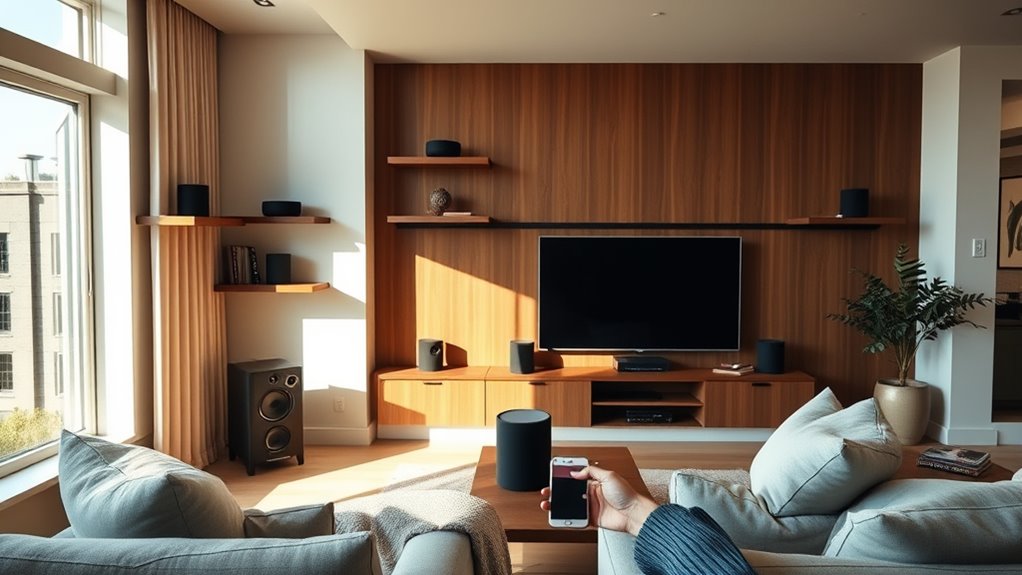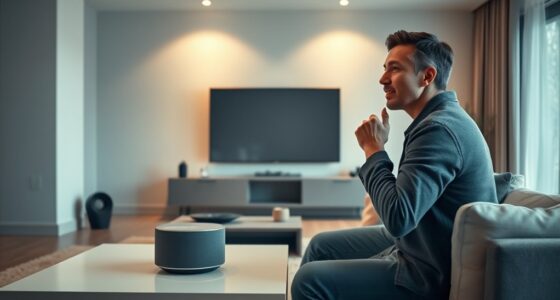To set up multi-room audio with smart speakers, start by choosing compatible devices that support your preferred ecosystem like Alexa, Google Assistant, or AirPlay 2. Place the speakers thoughtfully in each room, considering size, acoustics, and placement guidelines. Use the corresponding app or voice commands to connect, name zones, adjust settings, and synchronize playback. By understanding these basics, you’ll discover how to create a seamless, rich audio experience throughout your home.
Key Takeaways
- Install the manufacturer’s app on your device and connect all speakers to your Wi-Fi network.
- Assign names or zones to each speaker for easy identification and management.
- Use the app or voice assistants to group speakers for synchronized playback across multiple rooms.
- Fine-tune speaker placement, volume levels, and synchronization settings for seamless audio.
- Regularly update firmware and verify network stability to ensure reliable multi-room audio performance.
Choosing Between Closed and Open Multi-Room Systems
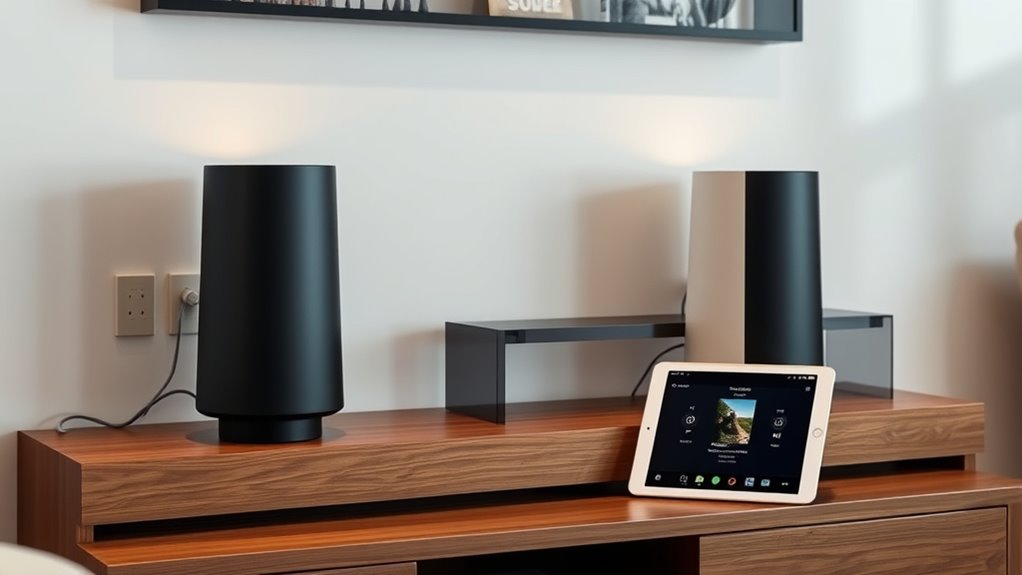
When selecting a multi-room audio system, you need to decide between closed and open options based on your priorities.
A closed system uses only speakers from the same manufacturer, controlled through a proprietary app. This setup offers a seamless user experience with easier setup and integrated features, making it ideal if you prefer simplicity. Additionally, it can help maintain home organization by centralizing control and reducing clutter from multiple apps or devices. This approach also minimizes compatibility issues, ensuring that all components work harmoniously together. Furthermore, a closed system can sometimes provide more reliable performance due to optimized hardware and software integration.
However, it limits device compatibility to one brand, reducing flexibility.
It restricts you to a single brand, limiting device options and flexibility.
Conversely, an open multi-room audio system uses shared protocols like AirPlay, Alexa, or Chromecast, enabling cross-brand device compatibility. This approach provides greater customization and flexibility, allowing you to integrate various devices you already own. Device compatibility is a key factor to consider when choosing between open and closed systems, especially if you want to expand or modify your setup in the future. Additionally, open systems often support a wider range of third-party devices, which can be advantageous for those seeking system expandability.
Your choice depends on whether you value a straightforward, streamlined user experience (closed system) or prefer system flexibility and device diversity (open system).
Additionally, understanding different water park features and amenities can help you create a relaxing atmosphere in your home, similar to the immersive experiences offered by top water parks.
Selecting the Right Smart Speakers for Your Home
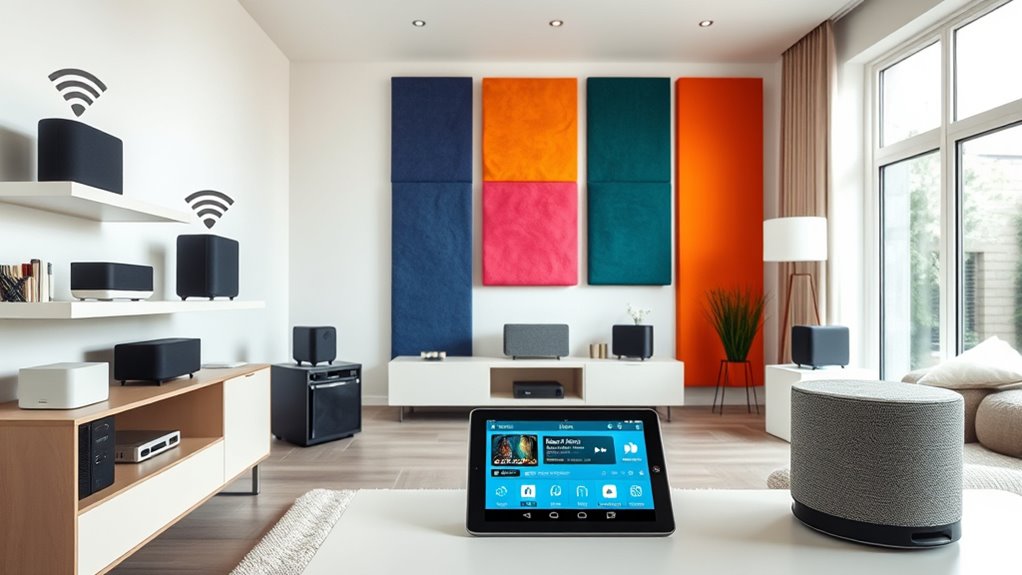
Choosing the right smart speakers starts with ensuring they work well with your existing devices and voice assistants. A good understanding of your audio setup can help you select speakers that integrate seamlessly into your home environment. Additionally, assessing the sound quality of potential speakers is important to ensure clear audio reproduction for your needs. Consider the compatibility with other devices to guarantee smooth operation across your smart home system. You should also evaluate the energy monitoring features if you aim to optimize energy consumption of your smart speakers and related appliances. Understanding the power consumption of different models can help you make more energy-efficient choices. Next, consider their sound quality, size, and how they fit into your room layout. Finally, check for features like multi-room capabilities and connectivity options to match your home’s setup.
Compatibility With Ecosystems
To guarantee your multi-room audio setup works seamlessly, it’s essential to select smart speakers that support your preferred ecosystem, like AirPlay 2 for Apple, Google Cast for Google, or Alexa for Amazon. Compatibility ensures smooth integration and simplifies control across devices. A good understanding of Bedroom design elements can help you choose speakers that complement your overall home aesthetic. When choosing smart speakers, consider these points:
- Confirm they support your ecosystem for better compatibility.
- Check if they work well with your existing smart home devices.
- Ensure compatibility with your smartphone’s OS for easy app access.
- Opt for speakers designed for your ecosystem, like HomePod or Nest Audio, for advanced features.
- Recognizing Private Placement Equity Markets can help you understand the investment landscape that influences technological innovation and funding strategies.
- Being aware of store hours can assist in planning the installation or purchase of your smart speakers at convenient times.
- Considering the Water-related technologies can promote sustainability and energy efficiency in your smart home setup.
- Paying attention to Material sustainability can also help you select eco-friendly options that align with your environmental values.
Focusing on compatibility guarantees your multi-room system functions efficiently, with fewer setup issues and more cohesive control across your smart home.
Sound Quality and Size
The size of your smart speakers considerably impacts their sound quality and suitability for different rooms. Larger smart speakers like the Apple HomePod (2nd gen) and Sonos One deliver superior sound quality with richer bass and clearer mids, thanks to bigger drivers and advanced acoustics. Healthy Kid Play emphasizes that engaging with a variety of play options can support overall development, much like choosing the right speaker size can optimize your listening experience. Additionally, the emotional safety created by appropriate speaker placement can enhance your overall audio environment, making it more enjoyable and immersive.
Furthermore, understanding the caffeine content in your speakers’ audio output, while not literal, can be likened to selecting devices with balanced sound profiles to prevent audio fatigue during extended listening sessions. Smaller models such as Google Nest Audio or Amazon Echo Dot are portable but may have limited bass response and lower volume, affecting their performance in larger spaces. The size influences the frequency range: bigger speakers produce deeper bass, while smaller ones excel in midrange clarity.
For multi-room audio, mixing sizes helps optimize sound coverage—larger speakers for main areas and smaller ones for auxiliary rooms. Consider your room size and acoustics when selecting smart speakers to ensure the best sound quality. Additionally, understanding the sound quality implications of speaker size can help you make better choices for your home setup, as speaker placement also plays a crucial role in overall audio performance.
Voice Control Features
Selecting the right smart speaker for your home hinges on understanding its voice control features and the virtual assistants it supports. Different smart speakers offer varying voice control capabilities, which impact your multi-room audio experience. Consider these key points: 1. Compatibility with multiple voice assistants like Alexa, Google Assistant, or Siri. 2. Seamless integration with existing smart home devices. 3. Language recognition capabilities for diverse household members. 4. Support for voice commands to control playback, volume, and smart home functions. Self Watering Plant Pots can provide insight into how well these devices manage different functionalities and user needs. Additionally, advancements in AI-powered voice recognition are improving the accuracy and responsiveness of these devices, making your multi-room setup more intuitive and efficient. Furthermore, selecting devices with robust compatibility ensures a smoother integration with various smart home systems, enhancing overall usability. Recognizing the importance of cultural intelligence in designing these systems can help accommodate diverse user preferences and linguistic differences, leading to a more inclusive experience. Incorporating knowledge about smart home ecosystems can also optimize how these speakers coordinate within a broader connected environment.
Planning Your Speaker Placement for Optimal Sound
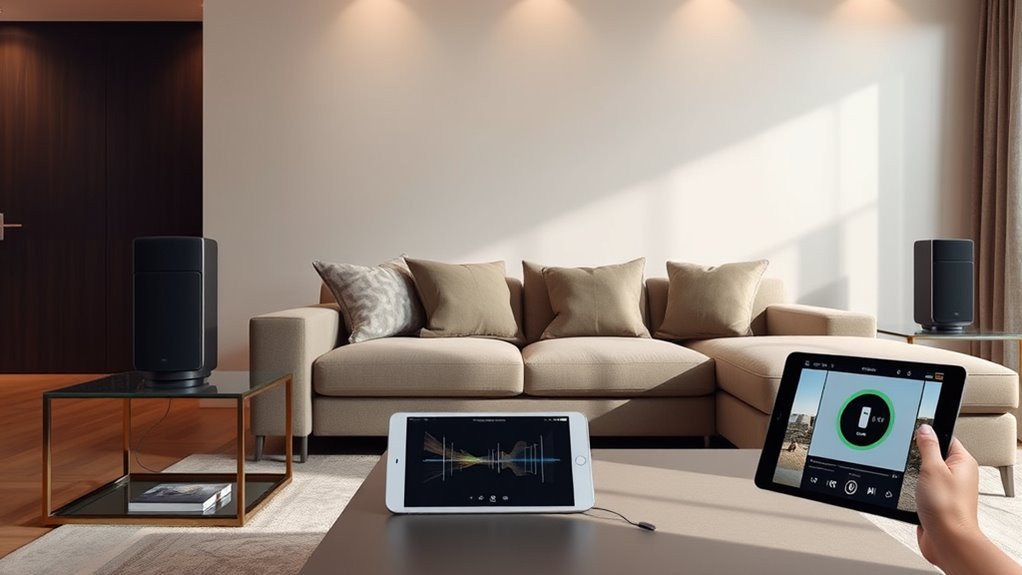
Achieving the best sound in your multi-room setup starts with thoughtful speaker placement. To ensure balanced sound distribution, assess each room’s size, shape, and acoustics before positioning your speakers. Properly managing cookie consent preferences can also enhance your setup experience by allowing you to customize your browsing and device use. Place them at ear level when seated for clear voice clarity and detail. Keep speakers away from walls and furniture to reduce sound reflections and enhance bass response. Distribute your speakers evenly throughout the space to prevent audio dead zones and create seamless multi-room audio. Take advantage of natural room features like windows and open doorways to optimize placement and minimize sound distortion or echo. Proper speaker placement directly influences sound quality and room acoustics, making it essential for a smooth multi-room audio experience.
Connecting and Configuring Your Multi-Room System

To set up your multi-room system, start by installing the manufacturer’s app on your device and powering on your speakers within Wi-Fi range.
Follow the app’s prompts to connect each speaker to your Wi-Fi network and assign names or zones for easy control.
Use the app to fine-tune settings like volume and synchronization, ensuring a seamless listening experience across all rooms.
Wireless Protocol Setup
Wondering how to guarantee your smart speakers work seamlessly together in your multi-room setup? The key is configuring the right wireless protocol for ideal connectivity.
First, ensure all your speakers support the same protocol, like Wi-Fi (2.4 GHz or 5 GHz), AirPlay 2, or Google Cast. Next, connect each speaker to your home Wi-Fi network via their app, following on-screen prompts.
Use the system’s app or control interface to discover and add new speakers, verifying they’re recognized. Finally, configure the wireless protocol settings within each device or app to enable proper synchronization.
To guarantee smooth multiroom audio, you should:
- Use compatible wireless protocols across all speakers
- Ensure strong Wi-Fi signals
- Regularly test playback zones
- Adjust network settings if needed
Device and App Configuration
Setting up your multi-room audio system begins with downloading and installing the manufacturer’s app, such as the Audio Pro app, on your smartphone or tablet.
Once installed, power on each speaker and connect them to your Wi-Fi network.
Open the app and use the “Add Device” or “+” feature to detect and connect each speaker automatically.
Follow the on-screen prompts to name each speaker and assign it to specific rooms or zones.
The app guides you through the setup and configuration process, allowing you to adjust playback settings like volume, equalizer, and synchronization options directly within it.
This streamlined approach guarantees seamless control and an optimized multi-room listening experience from your device.
Managing and Controlling Multiple Zones
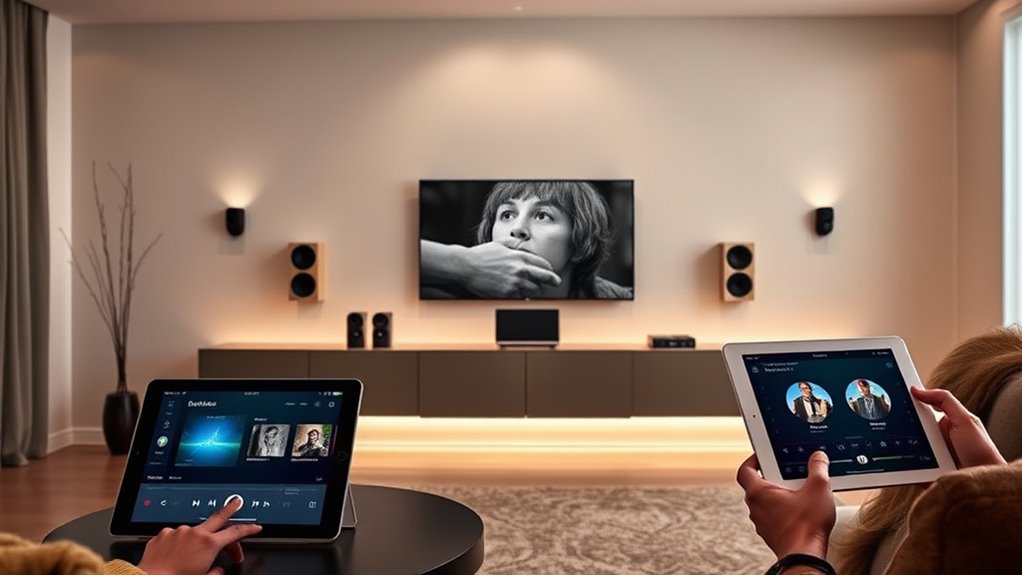
Managing and controlling multiple zones in a multi-room audio setup becomes straightforward when you leverage the right tools. With app control, you can easily manage each zone from your smartphone or tablet, adjusting volume, playback, or sources independently.
Voice assistants like Alexa, Google Assistant, or Siri allow hands-free zone management through simple commands.
To optimize zone management, consider these tips:
- Name each zone clearly to avoid confusion.
- Use the app to set default sources for different zones.
- Sync zones for whole-home playback or customize playlists per zone.
- Regularly update your system to ensure seamless multiroom audio performance.
These features make managing multiple zones more intuitive, providing personalized listening experiences across your smart home.
Integrating External Devices and Sources
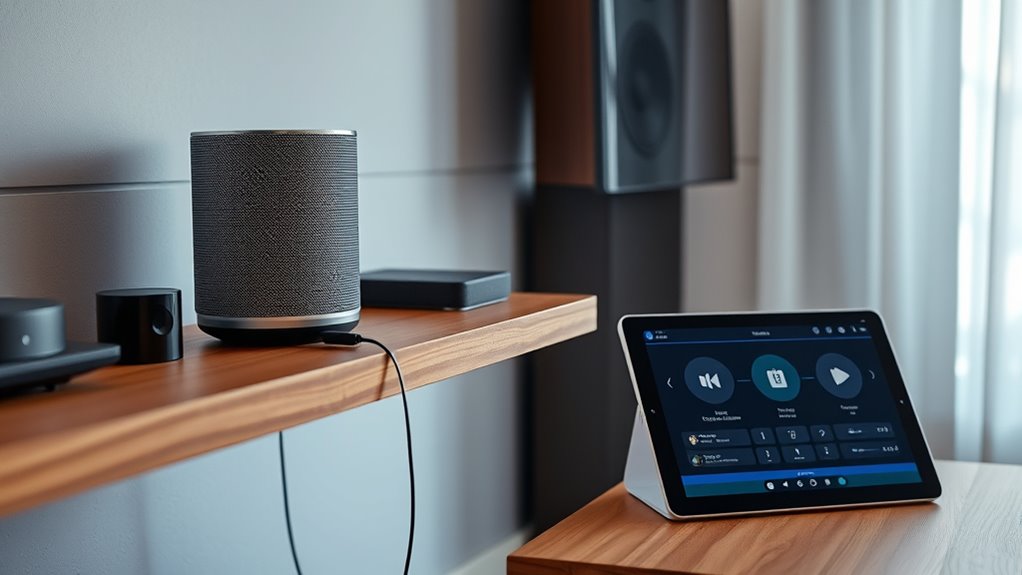
Integrating external devices and sources into your multi-room audio system enhances your listening options by allowing you to play content from a variety of equipment such as turntables, CD players, or network music servers. Compatibility is key; verify your devices support the system’s input types, whether analog or digital. Many smart speakers support streaming via Bluetooth, auxiliary, or network connections, making external integrations straightforward. Using adapters like Sonos Port or Bluesound Node, you can connect external sources directly to your system’s inputs. Some multi-room systems also allow direct integration through their app, centralizing control. Proper cabling, input selection, and calibration are essential for ideal sound quality and synchronization across zones.
| External Devices | Connectivity Options |
|---|---|
| Turntables, CD players | Line-in, digital inputs |
| Smartphones, tablets | Bluetooth, auxiliary |
| Network music servers | Network connections |
Tips for Maintaining and Expanding Your Setup
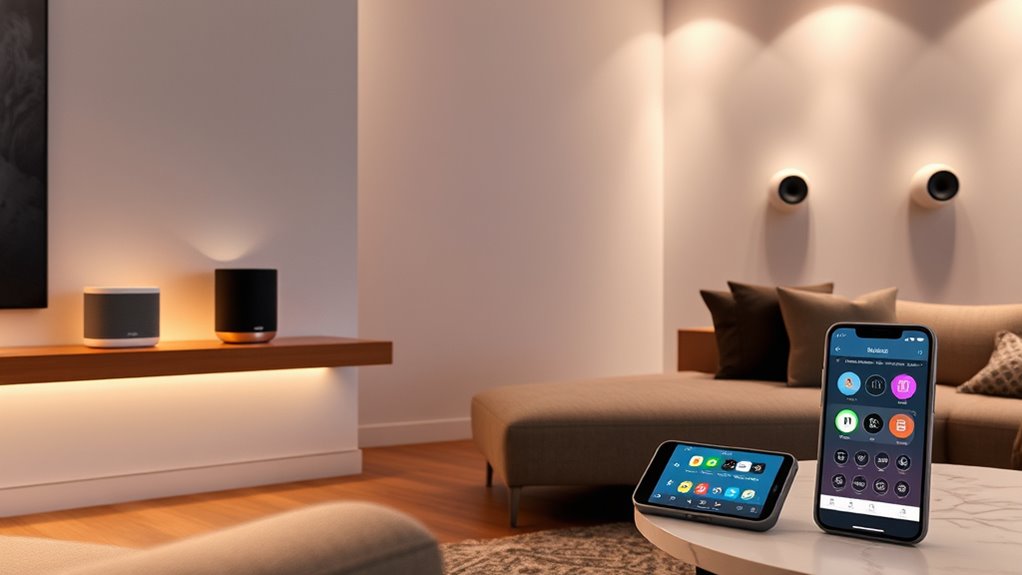
To keep your wireless multi-room setup running smoothly and ready for expanding your setup, regularly updating your smart speaker firmware and control app is essential. These updates improve compatibility, security, and reveal new features.
To maintain ideal performance, consider these tips:
- Use a robust, high-speed Wi-Fi network, like a mesh system, to prevent dropouts.
- Integrate smart home hubs or voice assistants to simplify control and automation.
- When adding new speakers, verify they support the same wireless protocols for seamless integration.
- Periodically test and calibrate speaker placement to enhance sound quality and minimize interference.
Staying current with firmware updates and maintaining a strong network helps you enjoy consistent audio performance, making it easier to expand your setup over time.
Frequently Asked Questions
How to Connect Speakers in Multiple Rooms?
To connect speakers in multiple rooms, start by ensuring all support the same wireless protocol.
Use the manufacturer’s app or compatible platform to add each speaker, following their instructions.
Place them in ideal spots with strong Wi-Fi signals, then connect each to the same network.
Finally, group or sync the speakers through the app for synchronized playback or individual control across your home.
How to Set up Multi Room Music?
To set up multi-room music, you first download the compatible app for your smart speakers.
Then, connect each speaker to your Wi-Fi, making sure they’re all on the same network.
Use the app to detect and add each speaker, assign them to rooms, and group them for synchronized playback.
Finally, customize volume and settings to enjoy seamless music across your entire home.
How Do I Stream Audio to Multiple Speakers?
To stream audio to multiple speakers, first verify all your devices are connected to the same Wi-Fi network.
Use compatible apps or protocols like AirPlay 2, Google Cast, or Alexa Multi-Room Music to select and sync your speakers.
You can control playback via your smartphone, voice commands, or smart home hubs.
Make sure your streaming service supports multi-room features for seamless, synchronized audio across all your speakers.
How to Connect Multiroom?
Think of connecting your multi-room setup like orchestrating a symphony—you’re the conductor. First, download the compatible app and turn on your speakers.
Connect each to Wi-Fi, then use the app to detect, add, and assign rooms. Group speakers, customize settings, and confirm connections.
Play audio to test harmony. With patience, you’ll create a seamless, immersive sound experience that feels as effortless as a well-conducted performance.
Conclusion
Setting up a multi-room audio system can feel like a puzzle, but with the right choices, it’s surprisingly simple—especially since some studies suggest your brain enjoys music more when it’s seamlessly integrated across your home. By selecting the right speakers, planning their placement, and staying organized, you’ll create a soundscape that feels natural and inviting. So go ahead, trust your instincts, and enjoy the immersive experience you’ve built—your home will thank you.
